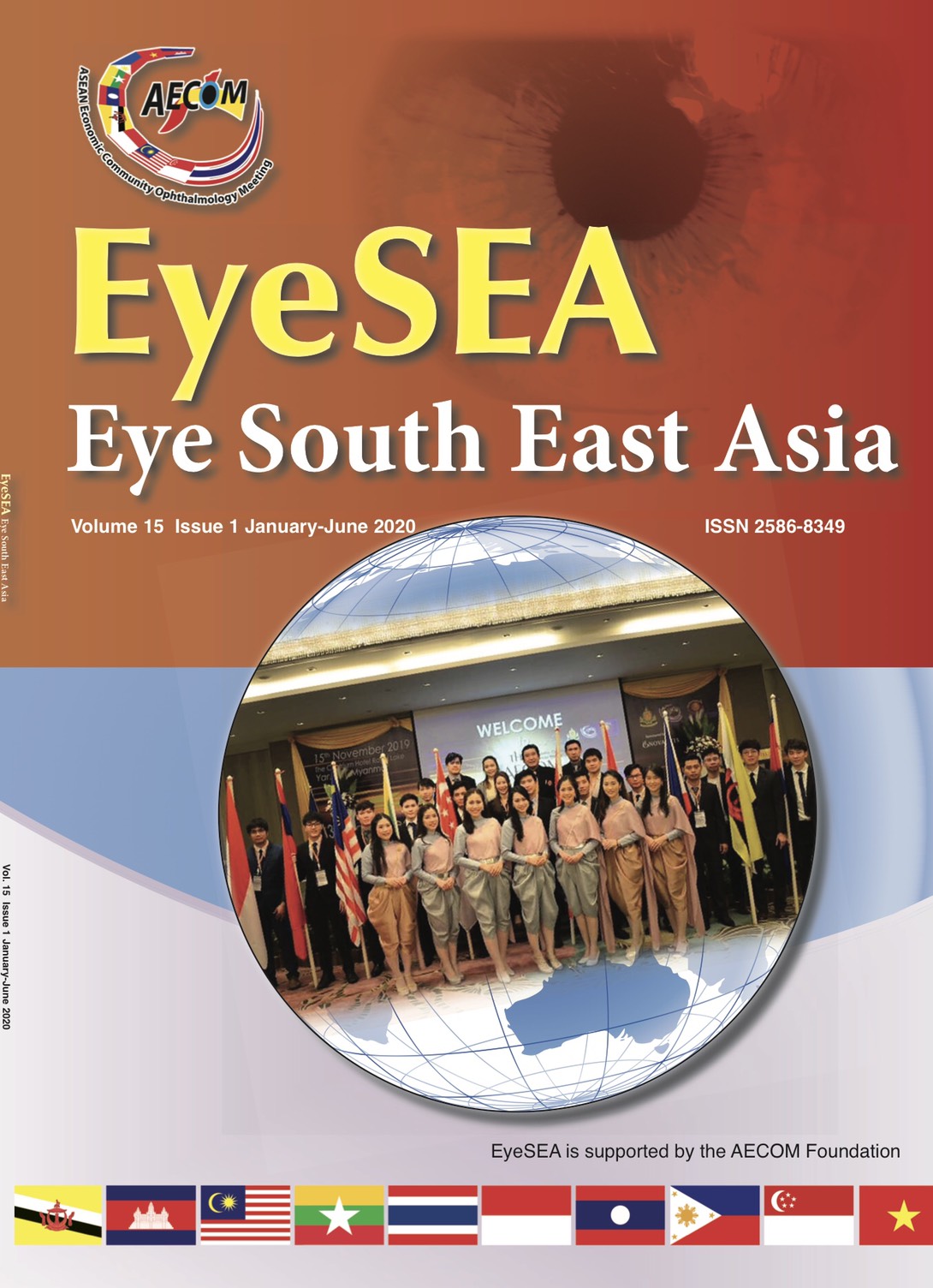Comparison of Two Techniques for the Decrease of Perfluoropropane Gas Volume in the Management of Retinal Detachment in Thammasat Hospital
Main Article Content
Abstract
ABSTRACT
Purpose: To compare the residual gas (perfluoropropane, C3F8) volume between fixed-concentration and fixed-volume method of air-gas exchange procedure used in rhegmatogenous retinal detachment surgery in Thammasat hospital.
Methods: We did a prospective, randomized clinical trial in the 56 patients whose eyes were diagnosed as rhegmatogenous retinal detachment and underwent pars plana vitrectomy combined with laser endophotocoagulation and air-perfluoropropane gas exchange. In the 28 patients whose eyes were in fixed-concentration group, air-perfluoropropane gas exchange was done by using 20% C3F8 50 cc replacing air within eye globe and the 28 eyes in fixed-volume group, 0.8 cc of 100% C3F8 was injected into the eye. We followed up 1 day, 1 week, and 1 month postoperatively to measure outcomes including post-operative intraocular gas volume (in percent), anatomical retinal reattachment rate and post-operative complications such as ocular hypertension and endophthalmitis.
Results: A total of 56 eyes (56 patients) with pars plana vitrectomy combined with laser endophotocoagulation and air-perfluoropropane gas exchange were performed in this study. The patients consisted of 34 men (60.7%) and 22 women (39.3%). Their ages were between 33-84 years old with a mean of 59.84 ± 10.4 years old. The mean post-operative residual intraocular gas volume for the fixed-volume method after 1 day, 1 week, and 1 month were 81.25 ± 8.57%, 62.14 ± 12.87%, and 31.25 ± 11.52% respectively. And the mean post-operative residual intraocular gas volume for the fixed-concentration method after 1 day, 1 week, and 1 month were also 85.36 ± 10.71%, 70.36 ± 17.74% and 38.93 ± 16.18% respectively. There were no significant difference in residual intraocular gas volume between the two groups in 1 day and 1 week postoperatively. After 1 month, there were difference of mean post-operative residual intraocular gas volume between 2 groups; 31.25 ± 11.52% for the fixed-volume method and 38.93 ± 16.18% for the fixed-concentration method (p>0.05). The anatomical retinal reattachment rates were 85.7% and 89.3% for the fixed-volume method and fixed concentration method, respectively. There was no difference in the rates of ocular hypertension between two groups, and none of the patient developed post-operative endophthalmitis.
Conclusions: Both techniques of air-perfluoropropane gas exchange in pars plana vitrectomy combined with laser endophotocoagulation was comparable when considering on the anatomical retinal reattachment rate, though there was smaller intraocular gas volume in fixed-volume technique when compared to fixed-concentration technique.
Keywords: Perfluoropropane Gas, C3F8, Residual gas volume, Air-gas exchange procedure, Rhegmatogenous retinal detachment surgery
Ethics: This study was approved for ethical research in human with the human research ethics committee of Thammasat university, Thailand (Research ID: MTU-EC-OP-0-244/61).
Article Details
References
2. Lincoff H, Mardirossian J, Lincoff A, Liggett P, Iwamoto T, Jako- biee F. Intravitreal longevity of three perfluorocarbon gases. Arch Ophthalmol 1980; 98:1610-1611.
3. Lincoff H, Haft D, Liggert P, et al. Intravitreal expansion of perfluorocarbon bubbles. Arch Ophthalniol. 1980; 98:1646.
4. Lincoff H, Coleman J, Kreissig I, Richard G, Chang S, Wilcox L. The perfluorocarbon gases in the treatment of retinal detachment. Ophthalmology. 1983; 90:546-551.
5. Cekic O, Ohji M. Intraocular Gas Tamponades. Seminars in Ophthalmology. 2000; 15(1):3–14.
6. Meyers S. M., Ambler J. S., Tan M, Werner J. C., & Huang S. S. Variation of perfluoropropane disappearance after vitrectomy. Retina. 1992; 12(4):359–363.
7. Bonnet M, Santamaria E, Mouche J. Intraoperative use of pure perfluoropropane gas in the management of proliferative vitreoretinopathy. Graefes Arch Clin Exp Ophthalmol. 1987; 225: 299-302.
8. Peters M. A., Abrams G. W., Hamilton L. H., Burke J. M., & Schrieber T. M. The Nonexpansile Equilibrated Concentration of Perfluoropropane Gas in the Eye. American Journal of Ophthalmology. 1985; 100(6):831–839.
9. Sabates NR1, Tolentino FI, Arroyo M, Freeman HM. The complications of perfluoropropane gas use in complex retinal detachments. Retina (Philadelphia, Pa.). 01 Jan 1996; 16(1):7-12.
10. Chang S. Intraocular gases. In: Ryan SJ, Wilkinson CP, eds. Retina. 3rd ed. St Louis: Mosby 2001:2417–61.
11. Al-Shahwan, S. Pupillary block glaucoma in phakic perfluoropropane gas filled eye. British Journal of Ophthalmology. 2006; 90(6):797–798.
12. Lincoff H. Weinberger D. Stergiu P. Air travel with intraocular gas. 11 Clinical considerations. Arch Ophthalmol. 1989; 107:907-910.
13. Thompson JT. Kinetics of intraocular gases. Disappearance of air, sulfur hexafluoride, and perfluoropropane after pars plana vitrectomy. Arch Ophthalmol. 1989; 107:687-91.
14. Shaheeda M, Timothy Y, Lai Y. Intraocular gas in vitreoretinal surgery. Hong Kong Journal of Ophthalmology. 2010; 14:8-13.
15. Harvey S. Uy, Miguel D. de Leon, Pearl T. Villalon. Comparison of two techniques for perfluoropropane gas fill in the management of retinal detachment. Phillippine Journal of Ophthalmology. 2007; 32: 66-69.
16. Cankurtaran V, Citirik M, Simsek M, Tekin K, & Teke M. Y. Anatomical and functional outcomes of scleral buckling versus primary vitrectomy in pseudophakic retinal detachment. Bosnian Journal of Basic Medical Sciences. Bosn J Basic Med Sci. 2017; 17(1):74-80.
17. Chang S, Lincoff HA, Coleman D, et al. Perflourocarbon gases in vitreous surgery. Ophthalmology. 1985; 92:651-656.
18. Anderson N. G, Fineman M. S, & Brown G. C. Incidence of Intraocular Pressure Spike and Other Adverse Events after Vitreoretinal Surgery. Ophthalmology. 2006; 113(1):42–47.
19. Vivek Pravin Dave, Avinash Pathengay, Stephen G Schwartz, Harry W Flynn Jr. Endophthalmitis following pars plana vitrectomy: a literature review of incidence, causative organisms, and treatment outcomes. Clinical Ophthalmology. 2014; 8:2183–2188.


